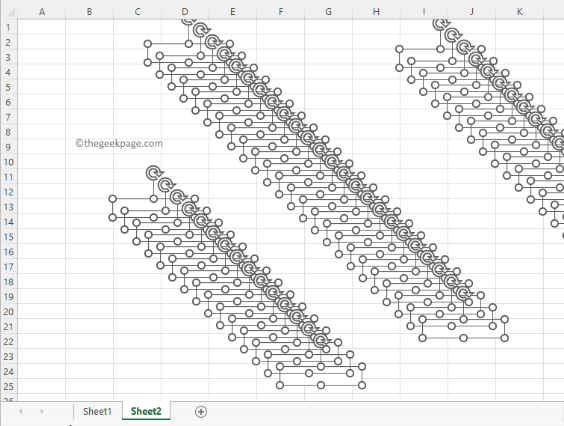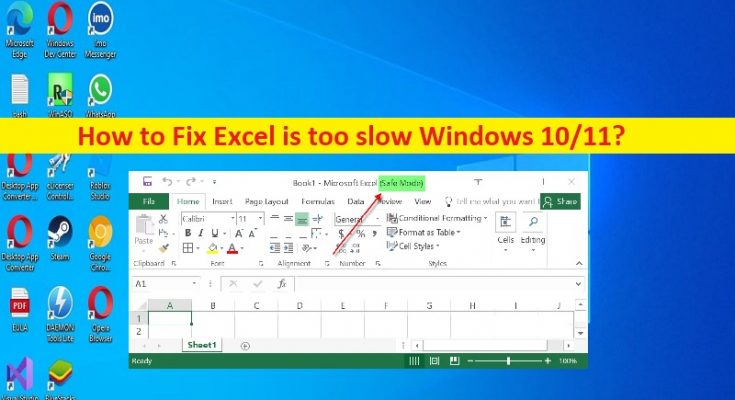What is ‘Excel is too slow’ issue in Windows 10/11?
In this article, we are going to discuss on How to fix Excel is too slow Windows 10/11. You are provided with easy steps/methods to resolve the issue. Let’s starts the discussion.
‘Excel is too slow Windows 10/11’:
MS Excel: Microsoft Excel or MS Excel is a spreadsheet developed by Microsoft Windows, macOS, Android and iOS. It features calculation or computation capabilities, graphing tools, pivot tables, and a macro programming language called Visual Basic for Applications (VBA). Excel is part of Microsoft Office suite of software. It has battery of supplied functions to answer statistical, engineering and financial needs. It allows sectioning of data to view its dependencies on various factors for different perspectives.
However, several users reported they faced Excel is too slow Windows 10/11 when they launch and run MS Excel. This issue indicates you are unable to use MS Excel comfortably in your Windows computer for some reasons. Slow Excel spreadsheet means you might face the time to process operations is taking a long time, calculation speeds have been reduced, and take a long time to open some Excel files.
The possible reasons behind the issue can be the too much use of conditional formatting: file corrupts regularly, slow to open, and slow the process of opening, having picture links in sheet slows down changing formats or entering numbers, the presence of hidden name ranges slow down the navigation between cells, when an Excel sheet is linked to an unavailable printer, it is slow on the initial opening up. It is possible to fix the issue with our instructions. Let’s go for the solution.
How to fix Excel is too slow Windows 10/11?
Method 1: Fix Excel is too slow issue with ‘PC Repair Tool’
‘PC Repair Tool’ is easy & quick way to find and fix BSOD errors, DLL errors, EXE errors, problems with programs/applications, malware or viruses infections in computer, system files or registry issues, and other system issues with just few clicks.
Method 2: Remove conditional formatting

One possible way to fix the issue is to remove the conditional formatting in Excel spreadsheet.
Step 1: Open Excel sheet and click ‘Home’ tab at top, and in ‘Editing’ group, click ‘Find & Select’, and from submenu, select ‘Go to Special’
Step 2: Select the option ‘Conditional Formats’ and click ‘Ok’ button. It will take a long time to complete the task and it will show all the cells in sheet that have conditional formatting.
Step 3: Go to ‘Home’ tab and click ‘Conditional Formatting’ in ‘Styles’ group, select the option ‘Manage Rules’ to see if this problem is due to set of rules that are been used for formatting. If ‘Conditional Forming Rule Manager’ takes a long time to open up, it is clear indication that conditional formatting is the culprit
Step 4: You need to either remove these unnecessary conditional formats or build them in a more efficient manner. Select your entire worksheet by taking your mouse cursor to top-left corner of cells, go to ‘Home’ tab, and in ‘Styles’ group, click ‘Conditional formatting’
Step 5: Go to ‘Clear Rules’ menu and choose ‘Clear Rules from entire sheet’, and then check if the issue is resolved.
Method 3: Clear the picture links or objects

Another way to fix the issue is to clear the picture links or objects in Excel.
Step 1: Open the problematic Excel sheet and go to ‘Home’ tab, and in ‘Editing’ group, click ‘Find & Select’ button
Step 2: Select the option ‘Go to Special’ and choose the option by selecting the radio button next to ‘Objects’, and click ‘Ok’ button. You will see all the objects/pictures link in worksheet get selected.
Step 3: You can just press ‘Delete’ key on keyboard to delete selected picture/object links, and thecn check if the issue is resolved.
Method 4: Check for hidden rows/columns
Step 1: Right-click on the last row/column that is visible and then select ‘Unhide’ in order to unhide the row/columns.
Step 2: Now, go all the way to end to see if there are any calculations present there. You can use ‘CTRL + SHIFT + Arrow’ key to go to last column in a row.
Method 5: Look for hidden name ranges
Step 1: To view the name ranges, click ‘Format’ tab and select ‘Name Manager’ in ‘Defined Names’ section
Step 2: This will list out a few ranges present in your worksheet. Press ‘ALT + F11’ to open ‘Visual Basic for application editor’
Step 3: Right-click on your workbook and select ‘Insert > Module’. Copy & paste the code given below in the new module.
Sub UnhideHiddenNameRanges()
‘Unhide all names in the currently open Excel file
For Each tempName In ActiveWorkbook.Names
tempName.Visible = True
Next
End Sub
Step 4: Close VBA Editor to go back to your Excel sheet, and select ‘View’ tab and click ‘Macros’ dropdown and choose ‘View Macros’
Step 5: You will see the macro that you have created. Select this macro and select the option ‘This Workbook’ in dropdown next to ‘Macros in’, and click ‘Run’ button to unhide the name ranges.
Step 6: Go to ‘Formulas > Name Manger’ and click ‘Scope’ column to sort them based on their scope.
Step 7: After that, select all name ranges having Workbook as scope and select the first one, hold ‘SHIFT’ key pressed and go to last one and select it, and click ‘Delete’ button at top and confirm it.
Method 6: Check for link to Disconnected/unavailable printer
Step 1: Press ‘Windows + R’ keys on keyboard, type ‘ms-settings:printers’ in ‘Run’ window and hit ‘Ok’ button to open ‘Printer & Scanners’ settings app
Step 2: Make sure that the toggle associated with ‘Let Windows Manage my default printer’ is ‘turned OFF’ in ‘Printer preferences’
Step 3: Select a printer that is available on system like ‘Microsoft print to PDF’ or any other PDF printer present, click ‘Set as default’ button and done.
Conclusion
I hope this article helped you on How to fix Excel is too slow Windows 10/11 with easy steps/methods. You can read & follow our instructions to do so. That’s all. For any suggestions or queries, please write on comment box below.



